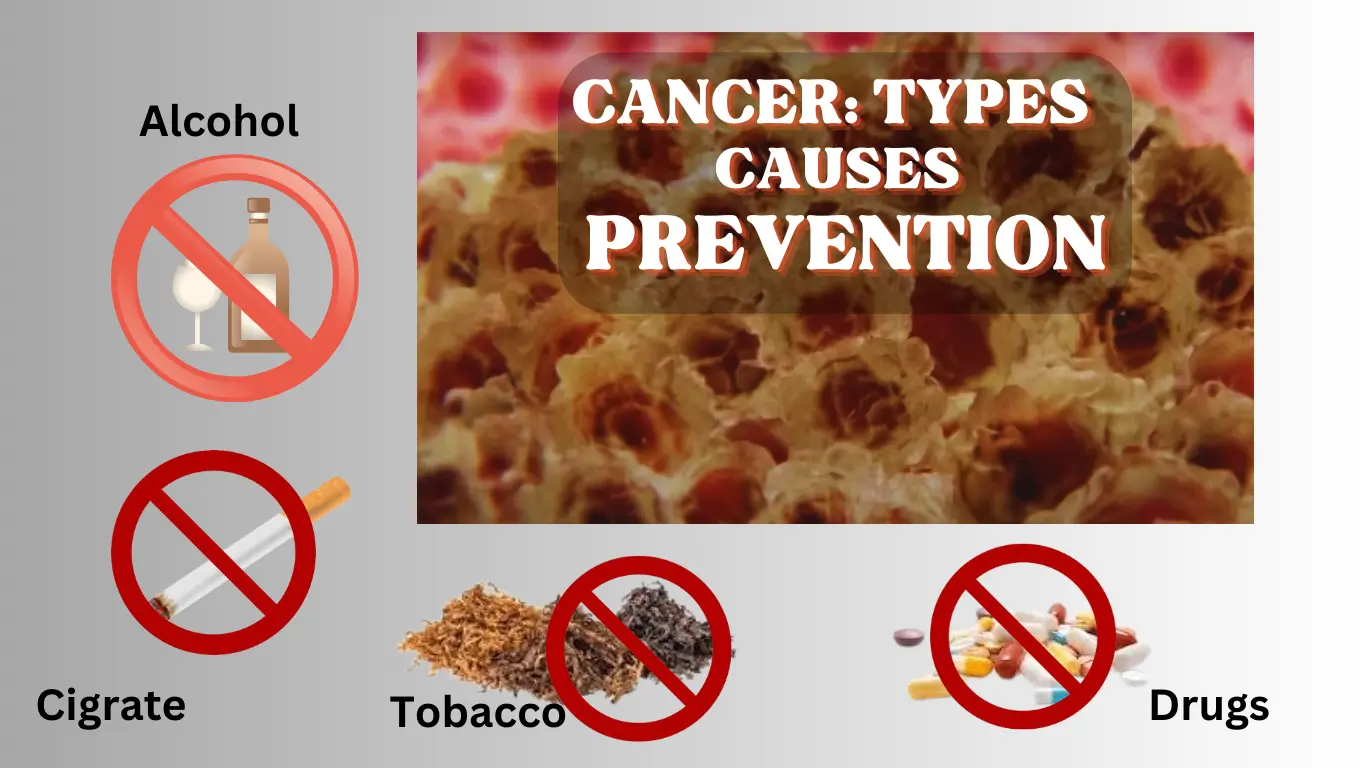Cancer is a widespread health concern impacting millions worldwide. In the U.S., over 1.8 million new cases are expected in 2022. These alarming numbers highlight the urgency of understanding cancer’s complexities, from its types and causes to prevention methods.
Contents
Types of Cancer
Cancer presents in diverse forms, each marked by irregular cell proliferation and the capacity to infiltrate surrounding tissues and organs. Among the prevalent types are breast, lung, prostate, colorectal, and skin cancer, although numerous other variations exist, highlighting the extensive spectrum of this ailment.
Here are some common types of cancer.
- Bladder Cancer
- Breast Cancer
- Colon and Rectal Cancer
- Endometrial Cancer
- Kidney Cancer
- Leukemia
- Liver Cancer
- Lung Cancer
- Melanoma
- Non-Hodgkin Lymphoma
- Pancreatic Cancer
- Prostate Cancer
- Thyroid Cancer
Additionally, cancers can also be classified based on their cell type:
- Carcinomas: Originate from epithelial cells.
- Sarcomas: Arise from connective tissues.
- Myelomas: Develop in plasma cells.
- Leukemias: Affects blood cells.
- Lymphomas: Involve the lymphatic system.
- Mixed types (including blastomas): Combinations of different cell types.
Reasons of Cancer
Understanding the reasons behind the development of cancer is crucial to devising effective prevention measures. Cancer can arise from a combination of genetic predispositions and environmental factors.
Genetic mutations inherited from family members can increase susceptibility to certain types of cancer, while environmental factors such as exposure to carcinogens, unhealthy lifestyle choices, and dietary habits can also contribute to its onset.
Genetic Predisposition:
- Inherited genetic mutations can increase cancer risk.
- Family history is a significant factor in certain cancers.
Environmental Factors:
- Exposure to carcinogens (e.g., tobacco smoke, pollutants) can trigger cancer.
- Unhealthy lifestyle choices (e.g., poor diet, lack of exercise) contribute to risk.
- Dietary habits play a role in cancer development.
Table summarizing various types of cancer and their associated risk factors:
| Type of Cancer | Description | Risk Factors |
|---|---|---|
| Carcinoma | Starts in the skin or tissues lining organs | Tobacco use – High alcohol consumption – Unhealthy diet – Lack of physical activity – Exposure to air pollution – Radiation exposure – UV light exposure – Infection by certain viruses |
| Sarcoma | Develops in connective tissues (bones, muscles, cartilage, blood vessels) | Genetic mutations – Environmental factors |
| Leukemia | Blood cancer affecting bone marrow and blood cells | Genetic predisposition – Exposure to radiation – Certain viruses |
| Lymphoma | Affects lymphatic system | Viral infections (e.g., Epstein-Barr virus, HIV) – Immune system disorders |
| Melanoma | Skin cancer originating from melanocytes | UV exposure – Fair skin – Family history |
| Breast Cancer | Develops in breast tissue | Gender (more common in women) – Age – Family history – Hormone replacement therapy |
| Lung Cancer | Originates in lung tissue | Smoking – Exposure to secondhand smoke – Radon exposure |
| Colorectal Cancer | Develops in the bladder lining | Age – Diet (high red meat consumption) – Family history – Inflammatory bowel disease |
| Prostate Cancer | Occurs in the prostate gland | Age – Family history – Race (more common in African American men) |
| Cervical Cancer | Affects cervix | HPV infection – Smoking – Immunodeficiency |
| Liver Cancer | Develops in liver cells | Chronic hepatitis B or C infection – Cirrhosis – Alcohol abuse |
| Pancreatic Cancer | Originates in pancreas | Smoking – Obesity – Diabetes – Family history |
| Ovarian Cancer | Affects ovaries | Age – Family history – Hormone replacement therapy |
| Bladder Cancer | Develops in bladder lining | Smoking – Chemical exposure – Chronic bladder inflammation |
| Kidney Cancer | Originates in kidney cells | Smoking – Obesity – High blood pressure |
| Thyroid Cancer | Affects thyroid gland | Radiation exposure – Family history |
| Brain Tumors | Develops in brain tissue | Genetic mutations – Radiation exposure – Rare inherited conditions |
Remember that these risk factors are not exhaustive, and individual cases may vary. Regular screenings and early detection play a crucial role in managing cancer risk. If you have any concerns, consult a healthcare professional for personalized advice.
Prevention of Cancer
While cancer can appear overwhelming, there are proactive measures individuals can employ to lower their risk. Embracing a healthy lifestyle, characterized by regular physical activity, a nutritious diet abundant in fruits and vegetables, and abstaining from harmful habits such as smoking and excessive drinking, can markedly diminish the chances of cancer onset.

Furthermore, prioritizing early detection through routine screenings and medical examinations is critical in detecting and managing cancer in its early stages.
- Healthy lifestyle: Engaging in regular physical activity, consuming a diet rich in fruits and vegetables, and avoiding smoking and excessive drinking can significantly reduce the risk of cancer.
- Early detection: Routine screenings and medical examinations are essential for detecting cancer in its early stages, which often improves treatment outcomes.
Here are some effective ideas for cancer prevention presented.
| Strategy | Description |
|---|---|
| 1. Don’t use tobacco | Smoking and chewing tobacco are linked to various cancers. Quitting tobacco is crucial for cancer prevention. |
| 2. Eat a healthy diet | While no diet guarantees cancer prevention, consuming fruits, vegetables, whole grains, and lean proteins can reduce risk. Limit refined sugars and alcohol intake. |
| 3. Maintain a healthy weight | Being at a healthy weight lowers the risk of breast, prostate, lung, colon, and kidney cancers. Regular physical activity also contributes. |
| 4. Protect yourself from the sun | Sunscreen, protective clothing, and avoiding tanning beds help prevent skin cancer. |
| 5. Get properly vaccinated | Vaccines can reduce the risk of cervical, liver, and other cancers. |
| 6. Limit processed meats | Consuming processed meat occasionally reduces the risk of certain cancers. |
| 7. Regular medical care | Regular screenings and check-ups aid in early detection and prevention. |
Remember, these strategies contribute to overall well-being and play a vital role in cancer prevention.
Healthy Lifestyle Practices
Incorporating healthy habits into daily routines is paramount in cancer prevention. Engaging in regular physical activity not only promotes overall well-being but also reduces the risk of obesity, a known risk factor for certain types of cancer.
Likewise, consuming a nutritious diet abundant in antioxidants and nutrients bolsters the body’s natural defenses against cancer-causing agents.
Avoidance of Harmful Substances
Tobacco use remains one of the leading causes of cancer worldwide, accounting for a significant proportion of cancer-related deaths. Stopping smoking and staying away from secondhand smoke are important actions to prevent cancer.
Similarly, limiting alcohol consumption and steering clear of other known carcinogens can mitigate cancer risk and promote overall health.
Importance of Regular Check-Ups
Regular medical check-ups and screenings are essential components of preventive healthcare. These screenings allow healthcare professionals to detect any abnormalities or early signs of cancer, enabling timely intervention and treatment.
By making regular health check-ups a priority, people can actively protect their health and overall well-being.
Screening Tests
Various screening tests are available for the early detection of cancer, tailored to different age groups and risk factors. Mammograms, Pap smears, colonoscopies, and skin examinations are examples of screening tests recommended for detecting breast, cervical, colorectal, and skin cancers, respectively.
Adhering to recommended screening guidelines can significantly improve the chances of detecting cancer at an early, treatable stage.
Promoting Awareness and Education
Raising awareness about cancer prevention and early detection is instrumental in empowering individuals to take charge of their health. Public health initiatives, educational campaigns, and community outreach programs play a vital role in disseminating information about cancer risk factors, screening guidelines, and available resources.
- Empowering individuals: Raising awareness can empower individuals to take control of their health by making informed decisions about their lifestyle and seeking early detection.
- Public health initiatives: Public health initiatives, educational campaigns, and community outreach programs are crucial for disseminating information about cancer risk factors, screening guidelines, and available resources.
- Combatting cancer burden: By fostering a culture of health literacy and proactive healthcare-seeking behavior, we can collectively reduce the impact of cancer.
Supportive Resources for Cancer Patients
For individuals facing a cancer diagnosis, managing the challenges of treatment and recovery can feel daunting. However, there exists a wealth of resources to offer assistance and guidance throughout this journey.

Support networks, counseling services, and online communities serve as valuable outlets for emotional support, providing a space to share experiences and connect with others facing similar circumstances. Additionally, patient advocacy groups and healthcare providers offer invaluable support in navigating treatment choices and accessing essential care services.
- Emotional support: Support networks, counseling services, and online communities can provide emotional support, allowing individuals to share experiences and connect with others facing similar challenges.
- Practical support: Patient advocacy groups and healthcare providers can offer guidance on treatment choices, access to essential care services, and navigating the healthcare system.
Advances in Cancer Research
The landscape of cancer treatment and prevention is continually evolving, thanks to ongoing research efforts and medical advancements. Breakthroughs in immunotherapy, targeted therapies, and precision medicine hold promise for more effective and personalized cancer treatments.
Additionally, innovations in early detection technologies and genetic screening tools offer new avenues for identifying individuals at increased risk of cancer and implementing preventive interventions.
- Evolving landscape: Ongoing research and medical advancements are leading to significant improvements in cancer treatment and prevention.
- Innovative treatments: Breakthroughs in immunotherapy, targeted therapies, and precision medicine are offering more effective and personalized treatment options.
- Early detection: Innovations in early detection technologies and genetic screening tools are enabling earlier identification of individuals at increased risk of cancer, allowing for preventive interventions.
Conclusion
In conclusion, cancer remains a formidable health challenge, but one that can be effectively addressed through collective action and individual empowerment. By understanding the various types of cancer, addressing modifiable risk factors, and embracing healthy lifestyle practices, we can reduce the incidence and impact of this disease. Through ongoing education, awareness, and research, we can pave the way toward a future where cancer is no longer a ubiquitous threat to public health.
FAQ’s,
What are the most common types of cancer?
Some of the most common types of cancer include breast cancer, lung cancer, prostate cancer, colorectal cancer, and skin cancer.
Are all cancers hereditary?
No, while certain cancers can be hereditary due to genetic mutations passed down through families, many cancers are caused by a combination of genetic and environmental factors.
How can I lower my risk of developing cancer?
Adopting a healthy lifestyle that includes regular exercise, a balanced diet, avoidance of tobacco and excessive alcohol, and adherence to recommended screening guidelines can help lower the risk of cancer.
At what age should I start getting screened for cancer?
Screening guidelines vary depending on individual risk factors and the type of cancer. It’s best to consult with a healthcare professional to determine the appropriate screening schedule for you.
What should I do if I’m diagnosed with cancer?
If diagnosed with cancer, it’s essential to seek guidance from healthcare professionals, explore treatment options, and access support resources such as support groups, counseling services, and patient advocacy organizations


awesome